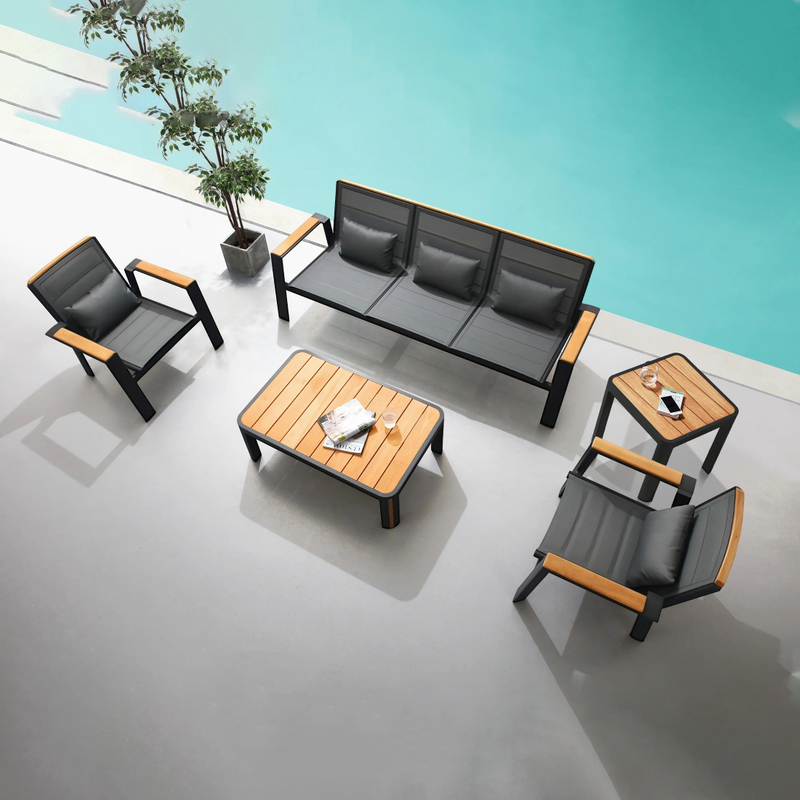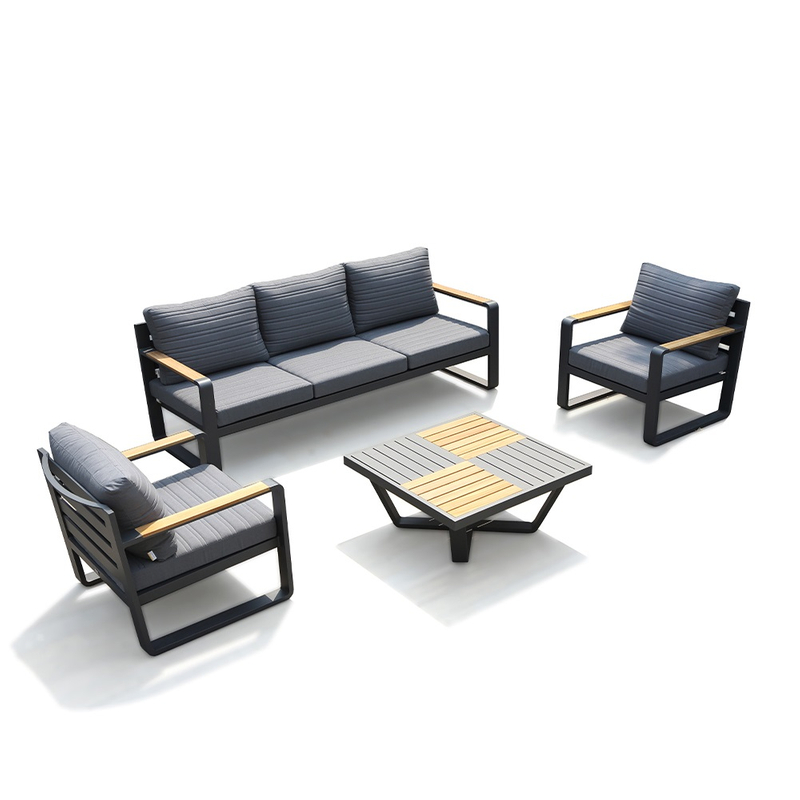How long do sofas last? It's a question many homeowners wonder about. The lifespan of your sofa impacts both comfort and your wallet.
A durable sofa can save you money by reducing the need for frequent replacements.
In this post, you’ll learn the factors that affect your sofa's longevity and how to make it last longer.

The materials used in your sofa can significantly affect how long it lasts. Let's break it down by different components:
A solid wood frame, such as oak or maple, is often the best choice for durability. These frames typically last between 10-20 years or more. They offer great support and can handle daily use. On the other hand, engineered wood may not last as long and is more susceptible to wear.
● Example of quality: "A well-constructed solid wood frame offers durability and support."
The type of upholstery you choose can also impact your sofa's lifespan:
● Leather: Properly cared for leather can last 15-20 years. It’s highly durable, resistant to wear, and easy to clean.
● Fabric: Sofas made of microfiber or linen blends last around 7-15 years. Microfiber is stain-resistant, while linen offers a breathable, natural feel.
● Tech Fabric : This modern material can last 8-12 years, offering high resistance to wear, stains, and water.
The filling inside your sofa affects comfort and durability. Polyurethane foam (also known as sponge) is common in sofas, but not all foam is equal:
● High-density foam maintains its shape longer and is more durable than low-density foam. It provides better support and lasts longer.
The quality of construction plays a significant role in how long your sofa will last. Here’s what to look for:
The type of springs inside the sofa affects comfort and lifespan. Here’s how:
● Coil Springs: These can last around 10-15 years and offer excellent support, reducing sagging over time.
● Sinuous Springs: While durable, they may not last as long as coil springs and tend to lose their shape quicker.
A well-built spring system helps maintain the sofa's structure, ensuring it remains comfortable for years.
Proper assembly is key to a long-lasting sofa. High-quality sofas are carefully assembled to ensure durability:
● Reinforced corners and strong joining techniques help prevent the sofa from loosening or falling apart.
● Example: "Each of our sofas undergoes a meticulous assembly process. The corners are reinforced, and all components are joined securely, resulting in a sturdy piece of furniture that will stand the test of time."
Over time, sofas start to show signs of wear. Here are some common issues to look for:
● Sagging Cushions or Uneven Seating: If the cushions start sinking or feel uneven, it’s a clear sign of wear. This affects comfort and support.
● Stains That Won’t Come Out: Persistent stains that don’t fade with cleaning can indicate fabric degradation.
● Fraying or Fading Fabric: Fraying edges or fabric that loses color are signs your sofa’s fabric is nearing the end of its life.
Knowing when to repair or replace your sofa can save you money and frustration.
● Minor Repairs vs. Major Issues: Small fixes like cushion re-stuffing or sewing up fabric tears can extend the sofa’s life. Major structural damage or widespread fabric issues may require replacement.
● How Often Should Sofas Be Reupholstered?: Sofas made from quality materials can often be reupholstered. Typically, this is needed every 7-10 years, depending on the fabric and usage.
Sofas in spaces like living rooms, offices, or waiting areas experience more wear. The constant use causes them to age faster. Here's how to manage the wear:
● Rotate Cushions Regularly: "If your sofa is in a living room where it's used daily, it's important to rotate cushions regularly." This simple step can help distribute the wear evenly and extend the sofa’s lifespan.
● Use Slipcovers: Protect fabric and leather from stains and spills by using slipcovers.
● Clean Often: Regular cleaning prevents dirt buildup, which can wear down the fabric over time.
Sofas in guest rooms or rooms used less frequently last longer. Since they aren’t subjected to daily use, the wear is less noticeable. The lack of frequent pressure and movement helps preserve the structure and fabric.
● Less Frequent Use: Sofas that aren’t used as often retain their shape and condition longer.
● Impact on Lifespan: Sofas in these spaces may only need light cleaning and occasional cushion fluffing, extending their useful life significantly.
Regular care can make a big difference in how long your sofa lasts. Here’s what you can do:
● Rotate Cushions Regularly: To prevent uneven wear, rotate cushions every few weeks. This helps distribute the pressure evenly and prevents sagging in one spot.
● Cleaning Instructions:
○ Leather Sofas: Wipe them down with a damp cloth and use a leather conditioner every few months to keep the material soft.
○ Fabric Sofas: Vacuum regularly to remove dirt and dust. For stains, check the manufacturer’s care instructions and clean them immediately.
○ Tech Fabric Sofas: Use a damp cloth to wipe away dirt. Tech fabrics are often resistant to stains, so regular cleaning should be enough.
● Protect from Sunlight and Humidity:
○ Example : "To extend the lifespan of your sofa, avoid placing it in direct sunlight. If your living room has strong sunlight, you can rotate the position of the sofas regularly to prevent obvious color differences."
○ Humidity: Keep your sofa away from humid areas to avoid mold and mildew growth.
Sometimes, professional help is necessary to keep your sofa in good shape:
● Professional Cleaning for Leather and Fabric Sofas: Regular deep cleaning can remove embedded dirt and maintain the sofa’s appearance. Professional cleaning also helps maintain the fabric’s softness and color.
● Re-stuffing Cushions or Repairing Frames: If the cushions feel flat or the frame is loose, it might be time for a professional repair. Re-stuffing cushions can restore comfort, and repairing the frame can prevent further damage.
Leather sofas are known for their durability. When properly cared for, they can last 15-20 years or more. This makes them a long-term investment.
Why do leather sofas last longer than fabric ones? Leather is naturally resistant to wear, making it less prone to fraying and fading. It also doesn’t absorb stains as easily, which helps it stay looking fresh longer.
Fabric sofas typically have a lifespan of 7-15 years, depending on the material and usage. There are several types of fabric:
● Microfiber: Known for being stain-resistant and easy to clean. It lasts longer than many other fabrics.
● Linen: While breathable and soft, linen tends to wear faster than microfiber and may show signs of wear in about 7-10 years.
● Other Fabrics: Sofas made from cotton or polyester blends may also last around 7-15 years, but their durability depends on the fabric’s quality and usage.
Sofas made with tech fabric offer a modern alternative. These materials typically last between 8-12 years. Tech fabrics are designed to be highly resistant to stains, water, and wear, making them ideal for families or high-traffic areas. Their durability and easy maintenance contribute to their growing popularity in the sofa market.

The materials used to make your sofa greatly impact how long it lasts. High-quality frames made from solid wood like oak or maple offer strong support and durability, lasting 10-20 years or more. Sofas with top-quality upholstery materials, such as leather or high-end fabrics, also tend to last longer since they resist wear, stains, and fading better than cheaper alternatives.
Where you place your sofa can affect its longevity. Here’s how:
● Direct Sunlight: Constant exposure to sunlight can cause fabric and leather to fade or crack.
● Humidity: High humidity can lead to mold growth or weakening of the frame, especially in wooden sofas.
● Pets: Pets can scratch the fabric or leather, leaving lasting damage. Their hair can also get embedded into the sofa.
To protect your sofa, avoid placing it in direct sunlight. Use protective covers or move it away from windows. If you live in a humid environment, consider using a dehumidifier or placing your sofa in a less humid room.
Regular cleaning and care can significantly extend your sofa's lifespan. A few simple steps include:
● Cleaning: Vacuum fabric sofas weekly to remove dust. Wipe down leather sofas with a damp cloth and use a conditioner for added protection.
● Preventive Care: Rotate cushions regularly to ensure even wear, and clean stains as soon as they appear.
● Attention: Pay attention to any small issues early on. Addressing minor repairs, like tightening screws or fixing small tears, can prevent bigger problems later.
Taking time to clean and care for your sofa ensures it will remain in good condition for years.
Opting for a custom-made sofa can significantly enhance its longevity. When you choose high-quality materials, the durability of the sofa increases. Custom frames, especially those made from solid wood like oak or maple, provide better support and can withstand years of daily use. Premium upholstery materials, such as top-grain leather or high-density fabrics, resist wear, stains, and fading, ensuring the sofa remains in great shape.
● Solid Wood Frames: Custom sofas with solid wood frames, instead of engineered wood, offer superior strength and resistance to sagging.
● High-Quality Upholstery: Leather, microfiber, and high-grade fabrics hold up better to wear and tear, extending the sofa’s useful life.
● Reinforced Stitching: Custom stitching techniques can make the upholstery more durable, reducing the chance of rips or tears.
● High-Density Foam: Choosing high-density foam for cushioning helps maintain its shape and comfort longer.
By investing in a customized sofa, you ensure it stands the test of time while offering the comfort and style you desire.
When shopping for a sofa, durability is key. Here’s what you should focus on:
● Solid Frame Construction: Always choose a solid wood frame (oak, maple) over engineered wood. Solid wood offers better strength and can last much longer.
● Durable Upholstery Materials: Leather, microfiber, and tech fabric are excellent choices for longevity. Leather is especially durable, while microfiber is stain-resistant and easy to clean. Tech fabric provides resistance to wear and stains, making it a great option for high-traffic areas.
● Spring Systems: Sofas with coil springs offer better support and durability than sinuous springs. They tend to last longer, typically around 10-15 years, without sagging.
To ensure you’re getting a long-lasting sofa, follow these tips:
● Research the Manufacturer’s Quality and Warranty: Look for brands known for quality craftsmanship. A solid warranty can give you peace of mind.
● Read Reviews and Check Sofa Construction Details: Check online reviews and inquire about how the sofa is built. Pay attention to the frame, stitching, and the materials used in the cushions.
By focusing on quality and construction, you can find a sofa that will stand the test of time.
A well-constructed sofa can last 10-20 years with proper care. Factors like material quality, construction, and maintenance impact its lifespan.
To maximize your sofa’s life, rotate cushions, clean regularly, and protect it from sunlight and humidity. These simple steps can keep your sofa in great condition for years.
